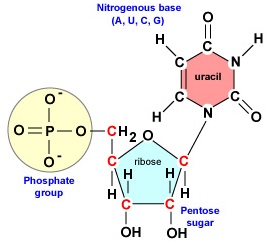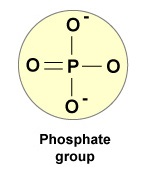19.6: Ribonucleic Acid (RNA)
- Page ID
- 3431
- State the 3 basic parts of a ribonucleotide.
- State 3 ways RNA differs from DNA.
- State the function of each of the following:
- tRNA
- mRNA
- rRNA
RNA is a single-stranded molecule composed of building blocks called ribonucleotides. A ribonucleotide is composed of three parts: a molecule of the sugar ribose, a nitrogenous base, and a phosphate group (Figure \(\PageIndex{1}\)).

Ribose is a ringed 5-carbon sugar (Figure \(\PageIndex{2}\)) similar to deoxyribose except it has a hydroxyl (OH) group) on its 2' carbon. The nitrogenous base is attached to the 1' carbon of the sugar and the phosphate group is bound to the 5' carbon. During RNA synthesis, the phosphate group of a new ribonucleotide is attached by the enzyme RNA polymerase to the 3' carbon of a ribonucleotide.

There are four nitrogenous bases found in RNA: adenine, guanine, cytosine, or uracil. Adenine and guanine are known as purine bases while cytosine and uracil are known as pyrimidine bases (Figure \(\PageIndex{3}\)).

A phosphate group (Figure \(\PageIndex{4}\)).

RNA differs from DNA in several ways. First of all, RNA is single-stranded, not double-stranded. Unlike DNA polymerases, RNA polymerases are able to join RNA nucleotides together without requiring a preexisting strand of RNA. In addition, RNA has the base uracil in place of thymine. Uracil, like thymine, can form hydrogen bond with adenine. Also, RNA and has the sugar ribose instead of deoxyribose. Finally, there are three functionally different types of RNA:
- Messenger RNA (mRNA): Messenger RNA copies the genetic information in the DNA by complementary base pairing and carries this "message" to the ribosomes where the proteins are assembled.
- Transfer RNA (tRNA): Transfer RNAs picks up specific amino acids, transfers the amino acids to the ribosomes, and insert the correct amino acids in the proper place according to the mRNA message.
- Ribosomal RNA (rRNA): Ribosomal RNA and ribosomal proteins form the ribosomal subunits.
- Other RNA transcripts: A variety of other RNA molecules transcribed off of DNA have also been found. These RNA molecules are not translated into proteins, but rather perform a wide range of direct genetic regulatory functions. Examples include antisense RNAs, microRNAs, and riboswitch RNAs.
RNA has the base uracil in place of thymine in DNA.
Summary
- RNA is a single-stranded molecule composed of building blocks called ribonucleotides.
- A ribonucleotide is composed of 3 parts: a molecule of the sugar ribose, a nitrogenous base, and a phosphate group.
- RNA differs from DNA in several ways: RNA is single-stranded, not double-stranded; unlike DNA polymerases, RNA polymerases are able to join RNA nucleotides together without requiring a preexisting strand of RNA; RNA has the base uracil in place of thymine, but like thymine, uracil can form hydrogen bond with adenine; and RNA and has the sugar ribose instead of deoxyribose.
- There are three functionally different types of RNA: messenger RNA (mRNA), transfer RNA (tRNA), and ribosomal RNA (rRNA).
- Messenger RNA copies the genetic information in the DNA by complementary base pairing and carries this "message" to the ribosomes where the proteins are assembled.
- Transfer RNAs picks up specific amino acids, transfers the amino acids to the ribosomes, and insert the correct amino acids in the proper place according to the mRNA message.
- Ribosomal RNA and ribosomal proteins form the ribosomal subunits.
- A variety of other RNA molecules transcribed off of DNA have also been found, including antisense RNAs, microRNAs, and riboswitch RNAs. These RNA molecules are not translated into proteins but rather perform a wide range of direct genetic regulatory functions


